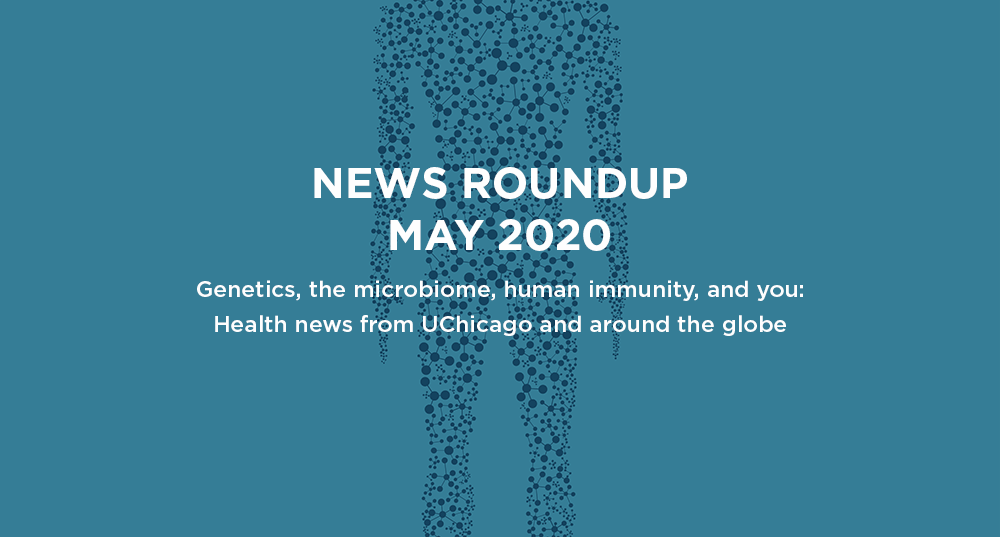
Jul 20, 2020 | Bioinformatics, Microbiome
by Elise Wachspress
Have you ever tried to follow a friend during a major marathon, like the one in Chicago?
This is only possible if you create a visible marker for either the runner, or—even better—the spectator, making it possible to identify each other in the huge crowds involved.
A red bandana is not going to cut it. You need something distinctive, highly visible and unusual, like maybe a giant letter “Q” balloon aloft above the throng!
Now imagine that you are trying to identify bacteria in the huge community of microbes nestled in your gut. Perhaps you want to find the particular ones involved in causing your illness or helping your body fight cancer. How do you identify these? Not only are there millions of “runners” in there, but they are reproducing hourly, which means the next generation might mutate and change the very “markers” you are using to follow them.
Nearly fifty years ago, Carl Woese, along with his graduate student Mitch Sogin, now a distinguished senior scientist at UChicago’s Marine Biological Laboratory in Woods Hole, Massachusetts, pioneered the use of a particular gene, called 16S ribosomal RNA, as a marker for microbes. Not only was the gene specific enough to identify types of bacteria; it was so “conserved,” or reliably unchanged over generations, that it became important as a “molecular clock” that could distinguish how closely bacteria might have been related over evolutionary history.
Woese used 16SrRNA to identify the archaea, a formerly unrecognized branch on the tree of life (and a great detective story!) Microbiologists now use the marker as a rapid, inexpensive shortcut to microbial identification. It’s just one of the arrows in the quiver of Sayantoni (Sam) Mukhopadhyay and her team as they study bacterial samples at the Duchossois Family Institute’s Microbiome Metagenomics Platform.
Mukhopadhyay’s team also helps researchers and clinicians sort out components of the microbiome with a newer, much more sensitive technique known as “shotgun metagenomics,” so called because of the somewhat scattershot way it targets pieces of the many genomes within a heterogeneous mixture. In this more complicated approach, the DNA from all the microbes in a sample is broken up into small segments and sequenced individually. After several rounds of fragmentation and sequencing, computer programs then identify the overlapping sections and reconstruct the sequences of the entire DNA strands from each bacterium.
This technique works especially well when some or all of the bacteria in the community have previously been grown in separate, pure colonies and fully sequenced by themselves. (Scientists and technicians have already laboriously sequenced the DNA of thousands of different bacteria and share these libraries.) These known bacteria become like the runners in a particular club who can always be identified by their specific combination of red bandana, white T-shirt, green shorts, and orange running shoes. Once these recognized sequences are accounted for, it’s easier to start homing in “new” bacteria DNA sequences not previously captured.
Not only can shotgun metagenomics provide an overview of complex communities of bacteria. It can also identify other DNA or RNA strands in a microbiome, like those in viruses—a benefit that seems clearer than ever in the time of coronavirus. Because shotgun metagenomics is so sensitive, the technique requires very careful preparation and handling of samples, so tiny DNA contaminants don’t skew the picture of what is actually going on in the microbial marathon.
And, as you might guess, the massive amounts of data involved require a lot of pretty sophisticated computational analysis. Eric Littman and Huaiying (Eddy) Lin are the seasoned bioinformaticians whose mathematical skills make sense of the endless combination of As, Cs, Gs, and Ts our internal athletes carry.
The new DFI Metagenomics Platform is a powerful tool for helping researchers and clinicians understand how microbial communities interact with each other and the human organism—information they are using here to understand how to resolve illness and, more importantly, promote health.

Jul 1, 2020 | COVID-19, Microbiome, News Roundup
Local EMT likely the world’s first double lung transplant recipient to survive COVID-19 via convalescent plasma. It was likely the only option to beat the disease for this young cystic fibrosis survivor, who received both the transplant and the plasma at UChicago Medicine. (Chicago Tribune)
UChicago will help with an experimental national vaccine trial for COVID-19. The study, spearheaded locally by the University of Illinois at Chicago, aims to test at least 1,000 people here. (Chicago Sun-Times)
The US is making progress on a universal flu vaccine. COVID-19 raises the stakes for fighting another infectious viral respiratory disease. (Axios)
Immune cells and noncancerous neurons can drive the growth of brain tumors in neurofibromatosis. Targeting those immune cells can help slow tumor growth. (Futurity)
Certain bacteria in the human gut may be driving a common liver disease. Researchers discovered the strain while studying a Chinese man who became intoxicated—without drinking—after eating high-carbohydrate meals, a condition they call “autobrewery syndrome.” (Science)

Jun 8, 2020 | Bioinformatics, Immunology, Microbiome
by Elise Wachspress
If you hang out with cutting edge scientists, you might hear or see the word (the suffix? a crossword puzzle answer?) “omics.” What are omics?
More than likely you‘ve heard of genomics, the study of the structure, function, evolution, and mapping of genomes, the collection of all the DNA in each organism.
And perhaps you’ve heard of transcriptomics, the study of all the ways an organism’s DNA is “transcribed,” or written into smaller molecules, the RNAs. While the DNA provides the basic, relatively unchangeable blueprints, environmental needs in the cell prompt the activation of specific genes. It’s like the highway engineer who, using her part of the blueprint, stages and directs the construction of one of the on-ramps. She’s working in concert with the larger plan, but somewhat separately from those directing other parts of the project.
Then there’s proteomics, the study of the structure and function of all the proteins that carry out the business in the cells. If the genome is a blueprint, and the engineering crew the RNA, the proteins are the molecular machines and building blocks—the backhoes, drills, and concrete—used to carry out the design.
The newest of the ‘omics fields is metabolomics: the study of all the chemical outputs of our cells and every microorganism that lives in and on us. These molecules, taken together, reflect the entire, functioning system, like how the cars and trucks using the highway are moving and thus creating new capital for society. Metabolomics is something like Here or Google maps, measuring important indicators of how the system is performing at both the street and system level. In a biological system, a genome can tell you what is possible, but the metabolome tells you what is actually happening.
But these readouts are more complex and critically useful: how a particular drug is working, how our immune system is responding, how microbes inside us are contributing to our health or modifying their environment to outcompete others, or even how our brains are prompting our bodies to act, and vice versa. New metabolomics technologies can help scientists non-invasively identify disease biomarkers, discover microbial products that can become new drugs, and identify the safest, most efficient ways to maintain health.
Among the many important resources the Duchossois Family Institute (DFI) is developing at UChicago is a facility that specializes in metabolomics. Led by Jean-Luc Chaubard, the DFI Host-Microbe Metabolomics Facility will feature state-of-the-art mass spectrometry, a powerful analytical technique that can be used to detail the profile of complex mixtures, whether solid, liquid, or gas. With this and other advanced instrumentation, DFI scientists will be able to understand the balance of molecules in blood, plasma, saliva, fecal, and even tissue samples, as well as in the waste products left behind when microbes are cultured (grown) outside the body.
Chaubard and his group will be looking at many things: from neurotransmitters and amino acids to bile acids and short-chain fatty acids, recently identified as critical to a healthy immune system. They will use large chemical libraries to create specialized “panels” that can profile multiple metabolites simultaneously. With these capabilities on campus, individual investigators will have ready access to new assays tailored specifically to their work.
The Metabolomics Facility will also help DFI investigators hone experimental design, decide when and how best to collect and store samples, and prepare those samples for testing. Importantly, they will also help in the data analysis that is critical in massive data-collection regimens like mass spec.
Chaubard, with a background both in academia (at Memorial Sloan Kettering and Caltech) and business (as founding director of the Molecular Discovery Lab at Modern Meadow, in New Jersey) is up for the challenge. An entrepreneur at heart, he is excited to be launching a resource that will set up UChicago as a leader in studying the convergence of immunology, the microbiome, and human health: “Here at UChicago, I get to work with some of the best scientists and doctors in the world, translating their work into practical applications that range from mechanistic understanding of human biology to early disease detection and discovery of novel drugs. It’s an honor to have this opportunity to improve the human condition.”
The Metabolomics Center is just one of the new platform resources made possible by a $100 million gift from The Duchossois Family Foundation and Craig and Janet Duchossois. We will bring you descriptions of several more in the weeks to come.
Elise Wachspress is a senior communications strategist for the University of Chicago Medicine & Biological Sciences Development office.

May 29, 2020 | Microbiome, News Roundup
UChicago immunologist Cathy Nagler is developing immunotherapies for food allergies.
Work in her lab has launched a company focused on resetting the balance of beneficial bacteria in the gut to reduce the danger of foods like peanut butter. (Scientific American and Knowable Magazine)
Dodging the coronavirus is still the primary microbial concern of most Americans.
Chicago epidemiologist Emily Landon’s rules of thumb: outside beats inside, mask better than no mask, smaller groups rather than larger. (National Public Radio)
Maintaining a healthy microbiome during COVID-19 may be more important than ever.
Some clinicians in China have suggested that COVID-19 patients with gastrointestinal symptoms might be experiencing worse outcomes from the virus. (The Conversation and Gut-British Medical Journal)
Statins may work to improve the gut microbiome in patients with obesity.
Statins appear to increase gut diversity and reduce inflammation in these individuals. (Genetic Engineering & Biotechnology News)
Environmental contaminants strongly influence gut microbiome health.
Scientists at the University of Illinois at Urbana-Champaign have linked dozens of chemicals, including bisphenols and phthalates (plastic food packaging); PCBs and perfluorochemicals (nonstick cookware); and pesticides and herbicides, to changes in the gut microbiome and health issues. (Technology Networks)

May 4, 2020 | Microbiome, News Roundup
Can plasma from patients who survived coronavirus help treat COVID-19 patients?
Clinical trials at UChicago Medicine are about to find out. (Chicago Tribune)
Did a UChicago researcher discover the first coronavirus?
In 1965, Dorothy Hamre took up the challenge to study students with colds and identified a new kind of virus. (Forbes)
A mutant enzyme that might solve a recycling crisis
Discovered in a compost heap, this enzyme can reduce bottles to chemical building blocks in a matter of hours. (The Guardian)
Do early solid foods predispose babies to be overweight?
Research from Johns Hopkins suggests changes in the microbiome in infancy can affect babies over a lifetime. (Futurity)
The breast is best, perhaps especially for preemies.
A study in newborn mice shows a component of breast milk may help protect premature babies from developing sepsis. (Futurity)

Apr 13, 2020 | Immunology, Microbiome
by Helen Robertson
In 1933, identical twin baby boys Oskar Stohr and Jack Yufe were separated as a consequence of their parents’ divorce. Their subsequent upbringings could not have been more different: Oskar was brought up as a Catholic in Germany and became an enthusiastic member of the Hitler Youth. Jack remained in the Caribbean where they were born, was Jewish, and even lived for a time in Israel. Yet when they were reunited some fifty years after they last saw each other they had an uncanny number of similarities. They shared thought patterns, walking gait, a taste for spicy food, and perhaps most unusually, a habit of flushing the toilet before using it.
The unfortunate separation of identical twins provides scientists with an exceptional laboratory for exploring the “nature vs nurture” conundrum. How much of our identity is conferred by our genes, and how much is a product of the environment in which we are raised? This is also true for our microbiome: twin studies have shown that the microbiomes of identical siblings are far more similar than those of fraternal twins, indicating that genes are at play.
UChicago researchers Alexander Chervonsky, PhD, and Tatyana Golovkina, PhD, are particularly interested in exploring how genetics—especially the genes that control our immune system— influence the composition of our microbiome. They chose to explore this question with mice.
Both mice and humans have two types of immunity: innate, “inborn” immunity, the first line of defense against pathogens, and adaptive immunity, in which immune cells are trained by the specific pathogens they encounter to fight off the same bad guys in the future.
To make sure all the mice used in the study started with the same microbes, Chervonsky and Golovkina needed to isolate them from the regular, bacteria-filled world. A normal mouse—much like a normal human—is born into an environment with trillions of bacteria, spread to them from their mothers and cagemates, their handlers, bedding, and food. Fortunately, UChicago’s special germ-free “gnotobiotic” mouse facility allows scientists to experiment on mice born and raised in an environment that hosts precisely zero bacteria, which make the mice experimental blank slates.
The researchers transferred microbes from a source mouse, raised in a conventional environment, to several strains of germ-free mice: some genetically identical, others with slight differences in their immune-response genes. In collaboration with computational immunologist Aly A Khan, PhD, they compared the resulting microbiomes to see if changes to immune system genes resulted in different types of microbial communities.
They found that differences in the adaptive—targeted—immunity caused minimal differences in microbial composition, and that those differences affected only certain strains of bacteria. Other types of bacteria even took advantage of the genetic differences and multiplied.
The team was surprised to discover that it was the innate immune response—the one the mice were born with, that needs no training: it was more active in shaping the microbiome. But even then, the total influence over the microbes in the mice’s gut was fairly small, meaning there were likely other genetic and non-genetic factors at play in determining how bacteria colonized and proliferated in the animals guts.
The team intends to look deeper into understanding how genes and microbes influence each other in developing animals. But this study sets a valuable benchmark for future microbiome work: closely documenting how the immune system worked here in germ-free mice means comparisons against other studies are standardized. Now we have a better idea of the “nature” side of the equation.
The Gnotobiotic Research Animal Facility is a vital asset for researchers at UChicago, and just one example of the gold standard approaches being used by the Duchossois Family Institute to improve our understanding of the underlying components of health and wellness.
Helen Robertson is a postdoctoral scholar in Molecular Evolutionary Biology at the University of Chicago, with a keen interest in science communication and science in society.









